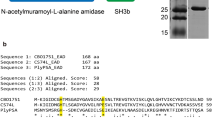Summary
Ten strains of Clostridium botulinum (5 type A and 5 type B) were combined and tested for their ability to produce toxin in modified reinforced clostridial medium, pH 5.7, under different amounts of pressure of carbon dioxide at 30° C. At atmospheric pressure (101 kPa), 100% CO2 delayed toxin production when compared with an atmosphere of 100% N2. Increasing the pressure level of CO2 further delayed the onset of toxin production; however, CO2 at 891 kPa absolute did not totally inhibit production of toxin, as two of 10 samples became toxic between 4 and 8 weeks of incubation. Pressurized CO2 was lethal to C. botulinum, with the rate of decrease of recoverable colony-forming units being dependent on the amount of pressure of CO2 and the length of exposure. However, CO2 at 816 kPa absolute did not serve as a fully protective antibotulinal agent as some of the surviving spores were capable of germination and producing toxin within 8 weeks at 30° C.
Similar content being viewed by others
References
Christiansen LN, Tompkin RB, Shaparis AB, Kueper TV, Johnston RW, Kautter DA, Kolari OJ (1974) Effect of sodium nitrite on toxin production by Clostridium botulinum in bacon. Appl Microbiol 27:733–737
Christopher FM, Seideman SC, Carpenter ZL, Smith GC, Vanderzant C (1979) Microbiology of beef packaged in various gas atmospheres. J Food Protect 42:240–244
Enfors S-O, Molin G (1978) The influence of high concentrations of carbon dioxide on the germination of bacterial spores. J Appl Bacteriol 45:279–285
Enfors S-O, Molin G, Ternström A (1979) Effect of packaging under carbon dioxide, nitrogen or air on the microbial flora of pork stored at 4° C. J Appl Bacteriol 47:197–208
Food and Drug Administration (1978) Bacteriological analytical manual. Association of Official Analytical Chemists. Arlington, Virginia
Hambleton R, Rigby GJ (1970) A study of the effect of carbon dioxide on the germination and outgrowth of spores of Clostridium butyricum using a slide culture technique. J Appl Bacteriol 33:664–673
Hays GL, Burroughs JD, Warner RC (1959) Microbiological aspects of pressure packaged foods. II. The effect of various gases. Food Technol 13:567–570
Hirsch A, Grinsted E (1954) Methods for the growth and enumeration of aerobic spore-formers from cheese, with observations on the effect of nisin. J Dairy Res 21:101–110
King AD Jr, Nagel CW (1975) Influence of carbon dioxide upon the metabolism of Pseudomonas aeruginosa. J Food Sci 40:362–366
Kritzman G, Chet I, Henis Y (1977) Effect of carbon dioxide on growth and carbohydrate metabolism in Sclerotium rolfsii. J Gen Microbiol 100:167–175
Silliker JH, Woodruff RE, Lugg JR, Wolfe SK, Brown WD (1977) Preservation of refrigerated meats with controlled atmospheres: Treatment and post-treatment effects of carbon dioxide on pork and beef. Meat Sci 1:195–204
Silliker JH, Wolfe SK (1980) Microbiological safety considerations in controlled-atmosphere storage of meats. Food Technol 34(3):59–63
Speck ML (ed) (1976) Compendium of methods for the microbiological examination of foods. American Public Health Association, Washington DC
Wells JM, Uota M (1970) Germination and growth of five fungi in low-oxygen and high-carbon dioxide atmospheres. Phytopathol 60:50–53
Wolfe SK (1980) Use of CO- and CO2-enriched atmospheres for meats, fish, and produce. Food Technol 34(3):55–58
Wynne ES, Foster JW (1948) Physiological studies on spore germination, with special reference to Clostridium botulinum. III. Carbon dioxide and germination, with a note on carbon dioxide and aerobic spores. J Bacteriol 55:331–339
Author information
Authors and Affiliations
Rights and permissions
About this article
Cite this article
Doyle, M.P. Effect of carbon dioxide on toxin production by Clostridium botulinum . European J. Appl. Microbiol. Biotechnol. 17, 53–56 (1983). https://doi.org/10.1007/BF00510572
Received:
Revised:
Issue Date:
DOI: https://doi.org/10.1007/BF00510572



